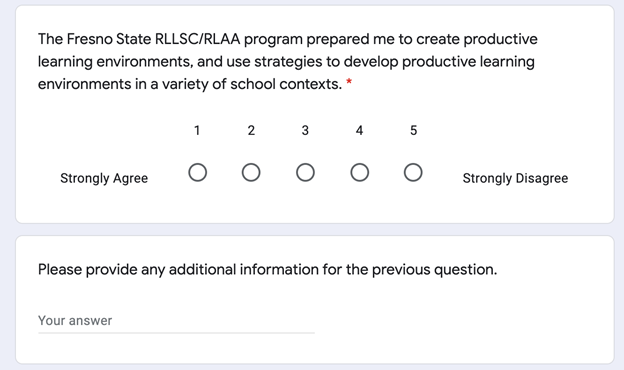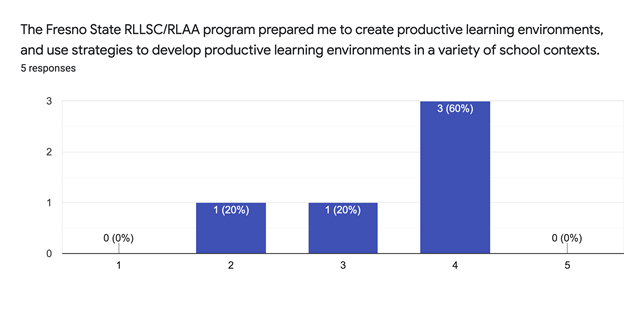AAQEP Accreditation
Standard 2 Aspect C
Standard 2c: Program completers engage in professional practice in educational settings and show that they have the skills and abilities to do so in a variety of additional settings and community/cultural contexts. For example, candidates must have broad and general knowledge of the impact of culture and language on learning, yet they cannot, within the context of any given program, experience working with the entire diversity of student identities, or in all types of school environments.
Candidate preparation includes first-hand professional experience accompanied by reflection that prepares candidates to engage effectively in different contexts they may encounter throughout their careers.
Data Sources & Analysis:
Data Source 1
LEE 230 Discussion Assignment
Perspective Captured from Data Source: Candidate
Rationale for using Data Source:
The LEE 230 Supervised Teaching in Reading/Language Arts discussion assignment highlights
students’ ability to identify and reflect on the ideological/philosophical underpinnings
of teaching reading, to assess their own stances, and to critically reflect on the
implications of that assessment.
Specific Elements of Data Source:
Discussion Prompt:
Traditionally, intervention and remediation have turned a blind eye toward students'
diverse backgrounds, focusing instead on cognitive development in relation to 'benchmarks'
of achievement. As Thomas & Dyches (2019) argue, the “basics-first emphasis commonly
associated with reading intervention curricula may result in districts assigning reading
intervention that helps students develop foundational literacy skills through interacting
with materials that perpetuate oppressive ideologies.”
In your opinion, why is it important for teachers to focus on students’ racial, cultural, and linguistic identities when we:
- identify students for intervention;
- develop meaningful intervention assessments and lessons;
- select literature and materials to use in intervention;
- strive to see students through an asset (strengths-based) lens?
Please bring our readings into your response. Posts should be approx. 1/2 to 1 page single-spaced. Respond to at least 1 of your classmates' posts (approx. 1 paragraph).
Definition of Success for Each Element:
It is crucial for educators to understand racism and other forms of oppression not
simply in terms of personal biases (i.e., bigotry), but as structural phenomena borne
in policies, procedures, and shared practices. To wit, this assignment asks students
to consider 1) how the intervention and remediation curriculum and processes used
by their districts may carry unstated racialized assumptions about children’s epistemologies,
and 2) why it is important for teachers to foreground identity vis-a-vis intervention
and remediation.
Determining “success” on such a task is not discrete, and certainly not one-and-done. In an inquiry-based program, student reflections must be ongoing and iterative. Successful student reflections are those that show a commitment to continued inquiry and that engage outside ideas, in this case, a research article and peer posts. As Britzman (1991) informs us: “practice makes practice.” Inquiry is imperfectable.
Dataset: Truncated and anonymized discussion board posts for five random students in 2019 and five random students in 2020 are included as the data source. Because this discussion prompt in LEE 230 began in the Fall 2019 semester, we only have two cycles of data.
Displays of Analyzed Data:
Candidates’ Understanding of the Relationship Between Student Engagement and Text
Selection
accordion1
| Semester | Student # Description | ||||||||||
|---|---|---|---|---|---|---|---|---|---|---|---|
| Fall 2019 |
|
||||||||||
| Fall 2020 |
|
Interpretation of Data:
As highlighted in the excerpted responses above, students in both 2019 and 2020 were eager to write about the relationship between children’s racio-cultural identities and their experiences in and of remediation/intervention. Candidates wrote critically and vulnerably, interrogating themselves and their sites of practice.
Candidates demonstrated a clear understanding of the relationship between providing students with texts that align with their interests and cultural backgrounds and students’ engagement in the learning. In order to create a positive learning environment when working with students on their literacy skills, educators need to be able to provide texts that students want to read. The responses above highlight the ways in which the program is preparing our candidates to do exactly that.
Data Source 2
Reading, Language, Literacy Specialist Credential Completer Survey
Perspective Captured from Data Source: Candidate/Completer (prior to graduation)
Rationale for using Data Source:
Although we used this data source for Standard 1, we are currently limited in the
types of data we have available. This data source is a good indicator for this standard,
but we will continue to develop additional data sources for future continuous improvement
cycles.
Beginning in Fall 2020, the RLLSC Program began administering a survey to candidates upon their completion of the program as a way to learn more about their perceptions of how well the program prepared them.
Using the RLLSC Completer Survey allows us to capture candidates’ perceptions of how well the program prepared them to use strategies and instructional approaches to develop productive learning environments in regards to language, reading, and writing.
Specific Elements of Data Source:

Definition of Success for Each Element:
Programmatically, our goal is for candidates to rate the program at a 4 or a 5 within
each area.
Displays of Analyzed Data:

Link to Full Dataset:
RLLSC Program Completion Survey Data (Names Redacted)
Interpretation of Data:
Because the program only began administering the completion survey in Fall 2020, we
only have one cycle of data to analyze. Of the 12 completers surveyed, all 12 provided
responses for a response rate of 100%.
Overwhelmingly, the completers who responded indicated they strongly agreed that the program prepared them to use a variety of instructional techniques in regards to language, reading, and writing.
Data Source 3:
Reading, Language, Literacy Specialist Credential Year+ Completer Pilot Survey
Perspective Captured from Data Source:
Program completer at least one year or more out of program completion
Rationale for using Data Source:
Beginning in late Spring 2021, the RLLSC Program administered a pilot survey to program
completers who completed the program at least one year or more prior to Spring 2021.
This pilot survey was administered to learn the perceptions of how well the program
prepared them.
Using the RLLSC Year+ Completer Pilot Survey allows us to capture candidates’ perceptions of how well the program prepared them with content and pedagogy necessary to carry out their role as Reading Specialists/ Literacy Leaders.
Specific Elements of Data Source:

Definition of Success for Each Element:
Because this is a new pilot survey we have not set a programmatic goal and are hoping
to learn areas of need for our program with this survey. Eventually, our goal is for
candidates to rate the program at a 4 or a 5 within each area.
Displays of Analyzed Data:
Data from May/June 2021 Data Cycle

Link to Full Dataset:
RLLSC Year+ Completer Pilot Survey (Names Redacted)
Interpretation of Data:
Because the program only began administering the Year+ Completer Pilot survey in May
2021, we only have one (partial) cycle of data to analyze. The pilot survey was sent
to 56 RLLSC program completers from years 2015-2020 in early May 2021 and again in
June 2021. As of July 14, 2021, five responded to the survey.
The completers who responded indicated a range of opinions on how the program prepared them to create productive learning environments and use strategies to develop productive learning environments. Three out of five respondents (60%) agreed the program prepared them in this aspect, one responded neither agreed nor disagreed, and one responded disagreed. There were no qualitative comments with the responses.
Next Steps:
The qualitative and quantitative findings indicate program candidates and completers
are well-prepared to create productive learning environments.
We will continue to collect the LEE 230 Discussion Prompt responses and send both the completer and Year + completer surveys out each year and as a program, analyze the data for feedback and trends. Additionally, we plan to conduct focus group interviews with year+ completers and develop an employer pilot survey, both of which will be created and piloted in the 2021-22 academic year.